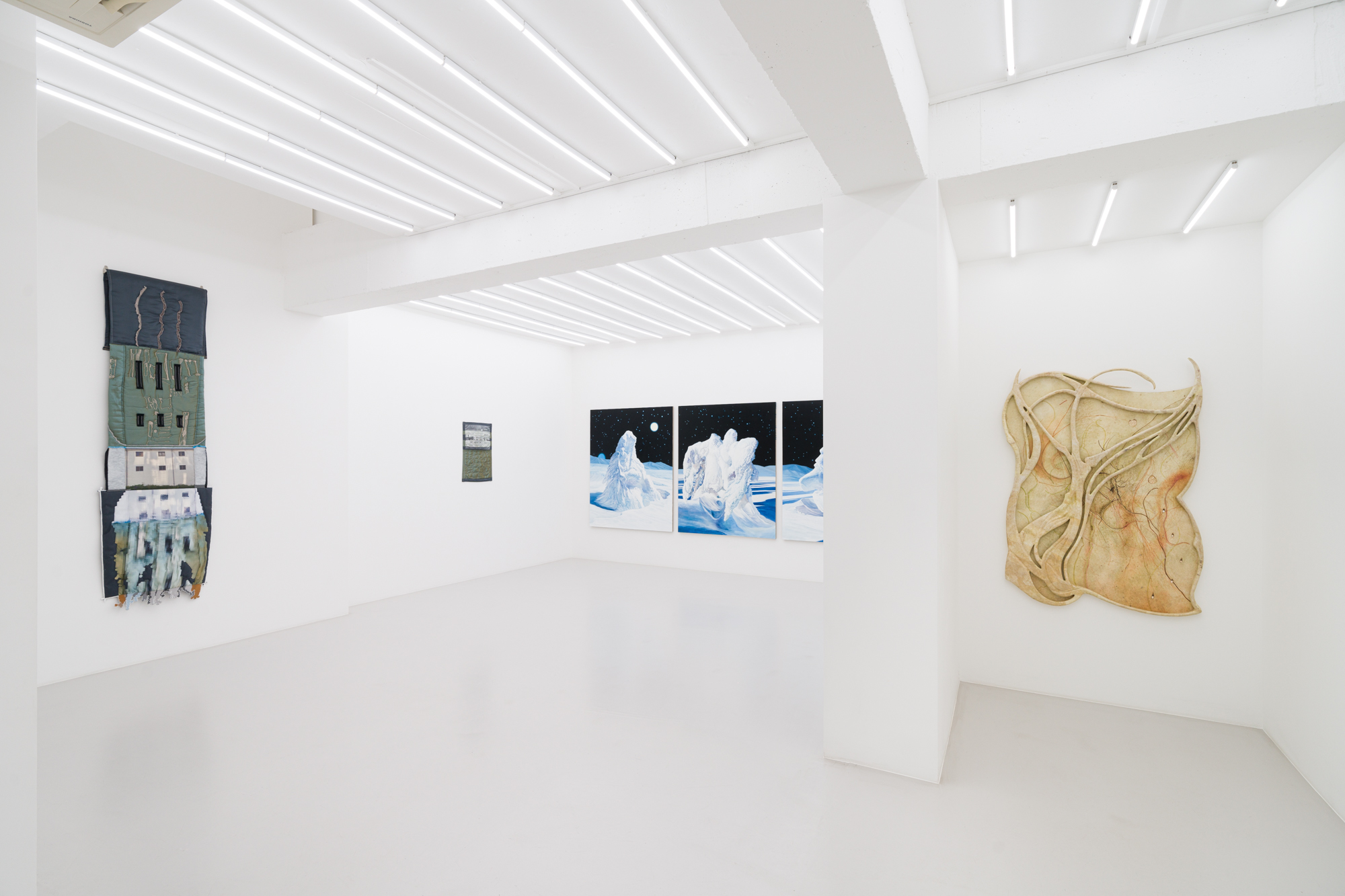심상적 풍경 : 자연으로부터
2024. 4. 17 - 5. 14 | [GALLERIES] GALLERY SOHEON & SOHEON Contemporary
김일권

갤러리소헌&소헌컨템포러리 전시전경
The New Landscape (새로운 풍경), 감동과 치유, 그리고 평화로움. 고요한 심상의 풍경을 그려내다
캔버스 속에 그어진 고요한 수평선의 깊은 울림이 새로운 ‘풍경’이 되어 마음속으로 다가온다. 김일권 작가는 한국적인 색채를 사용하여 자신이 바라본 자연의 순간을 작가만의 심상을 통해 ‘그 날’의 감정과 생각을 담아 풍경의 구상을 추상으로 전환시킨다. 캔버스의 평면을 가로지른 수평선을 경계로 하늘과 들, 혹은 하늘과 바다 등이 뚜렷하게 나뉘는 풍경을 강렬한 색의 대비로 표현하거나 혹은 어슴푸레하고 환영적으로 표현하여 추상화한다. 그의 캔버스에는 사계절이 담겨있고 새벽과 정오, 한낮의 푸름, 붉은 노을, 깊은 한밤중의 자연이 담겨있다. 어둠과 빛이 지나가고, 장엄한 정적, 깨어남, 순간에서 순간으로의 전환이 있다.
김일권 작가가 한 점의 작품을 완성하기까지는 적어도 한 달에서 때로는 몇 년이 걸리기도 한다. 작품을 자세히 들여다보면 겹겹이 쌓아올린 색의 층이 그 이유가 된다. 단순하게 면이 분할된 것이 아니라 칠을 올리고 나서 작가 스스로 만족할 때까지 여러 색깔을 덧 올려 깊이를 만들어낸다. 예를 들면 오묘한 빨간색 너울거리는 속에 노란빛이 섞여있고, 그 빛의 바탕에는 검정이 자리하면서도 보랏빛이 돈다. 덧 올린 층 사이로 마티에르가 불규칙하게 보이기도하고 반짝이는 펄이 보일 때도 있다. 작가가 덧 올린 세월이 작품 속에 고스란히 나타난다.

김일권, Untitled, 116.8×80.3cm, Oil on canvas
날짜 제목, 그리고 평안을 불러일으키고자 의도하는 ‘연상 풍경’
신기하게도 김일권의 작품들엔 날짜가 제목이 되어 따라 붙는다. 김일권의 풍경화는 시간성을 초월하고 환영과 같은 느낌을 주지만, 작가에게 그 특정한 날짜는 그 풍경이 숭고해지도록 맞춰진 가상의 시간에 대한 기록이다. 작가의 마음으로 바라본 그 날의 풍경과 느낌, 공기, 감정에 따라 다양한 모습으로 표현된다. 실제 풍경의 단순한 재현이 아니라 보는 이에게 마음의 감동을 주고 평안을 불러일으키고자 의도하는 ‘연상 풍경’이다. 캔버스의 평면을 가로지르며 아스라이 표현된 수평선은 각 작품들마다 시시각각으로 변하며 관람객이 작품 안에서 희망을 꿈꿀 수 있는 장소, 현실에 대한 대안적인 공간으로 영혼이 평화로운 자연 안에서 휴식할 수 있게 의도하고 있다.

김일권, untitled, 90.9×72.7cm, Oil on canvas
서양에서 인정받은 동양적 풍경추상
특히 김일권의 작품은 뉴욕 활동시절 미국 미술평단에서 동양적 심상을 담아 따뜻하고 긍정적인 아우라가 있는 풍경추상으로 좋은 반응을 얻었다. PRATT institute (프랫 인스티튜트)의 겸임교수이자 American art critic (아메리칸 아트 크리틱)의 로버트 C.모건은 “마치 마크 로스코의 추상이 생각나게 하지만 마크 로스코의 추상과 달리 더 미묘하며 어떤 점에서는 보다 힘차고 자발적이며 긴장감을 가지고 있는 ‘김일권’의 작품은 동양 풍경화의 전통인 간명한 고요함, 모호함이 없는 의미, 담대한 이해력과 사유의 감정을 보여주고 있다. 여기에서 우리는 인간적 정서의 우주를 발견할 수도 있고, 시간과 공간을 넘나들 때 우리의 감정을 지배하는 은하수의 분위기를 발견할 수도 있다.” 라고 말한다.

김일권, untitled, 80.3×65.1cm, Oil on canvas
김일권 작가는 뉴욕미술학교에서 MFA를 마치고 서강대 영상대학원 예술공학 박사과정을 졸업한 뒤 뉴욕시립대 연구교수를 거쳐 현재 전남대교수로 재직 중으로 뉴욕 유학 시절 백남준 사단의 일원으로 활동하기도 했으며 크리스티 옥션 뉴욕에 출품되어 여러 번 낙찰된 기록을 가지고 있으며, 포스코 미술관, 뮤지엄산, 토탈미술관 등 국내유수의 미술관을 비롯하여 뉴욕 첼시 앤드레 자르 갤러리 전속작가와 소호, 파리 등에서 전시한 바 있다. 그리고 서울 국립현대미술관, 뉴욕 총영사관, 뉴욕 한국문화원, 미국 Basf Urethan Co, 현대모터스 인디아, 서울 예술의 전당, 인디아 한국대사관, 신세계, 롯데호텔 제주, 대명리조트, 광주지방법원, 광주시립 미술관, NEW YORK ACADEMY OF ART 등에 작품이 소장이 되어 있다.
갤러리소헌&소헌컨템포러리
대구광역시 중구 동덕로 18, 2층
053 426 0621/010 9955 0621
WEB INSTAGRAM FACEBOOK YOUTUBE
[GALLERIES] GALLERY SOHEON & SOHEON Contemporary
- Dates
- 2024. 4. 17 - 5. 14











